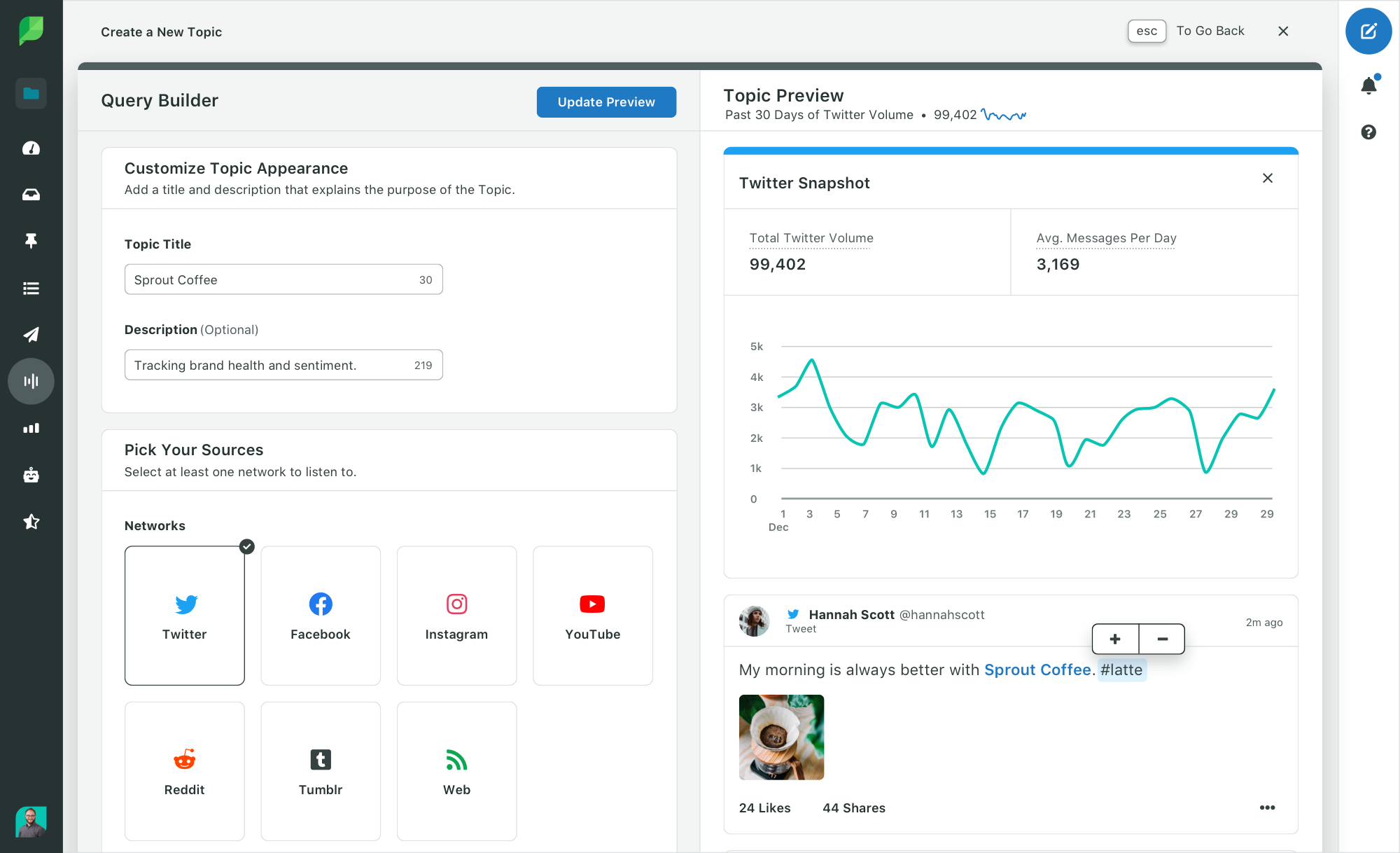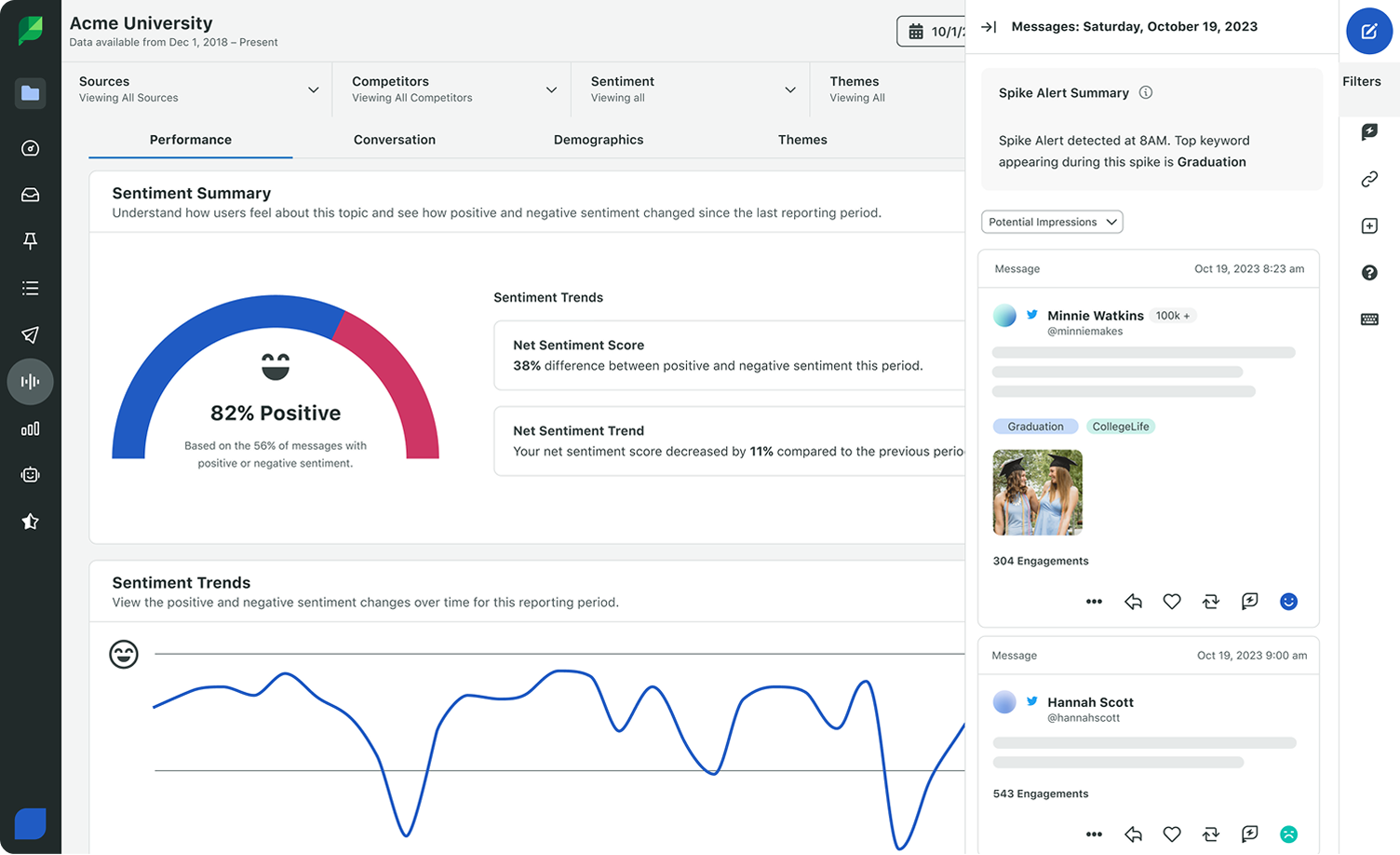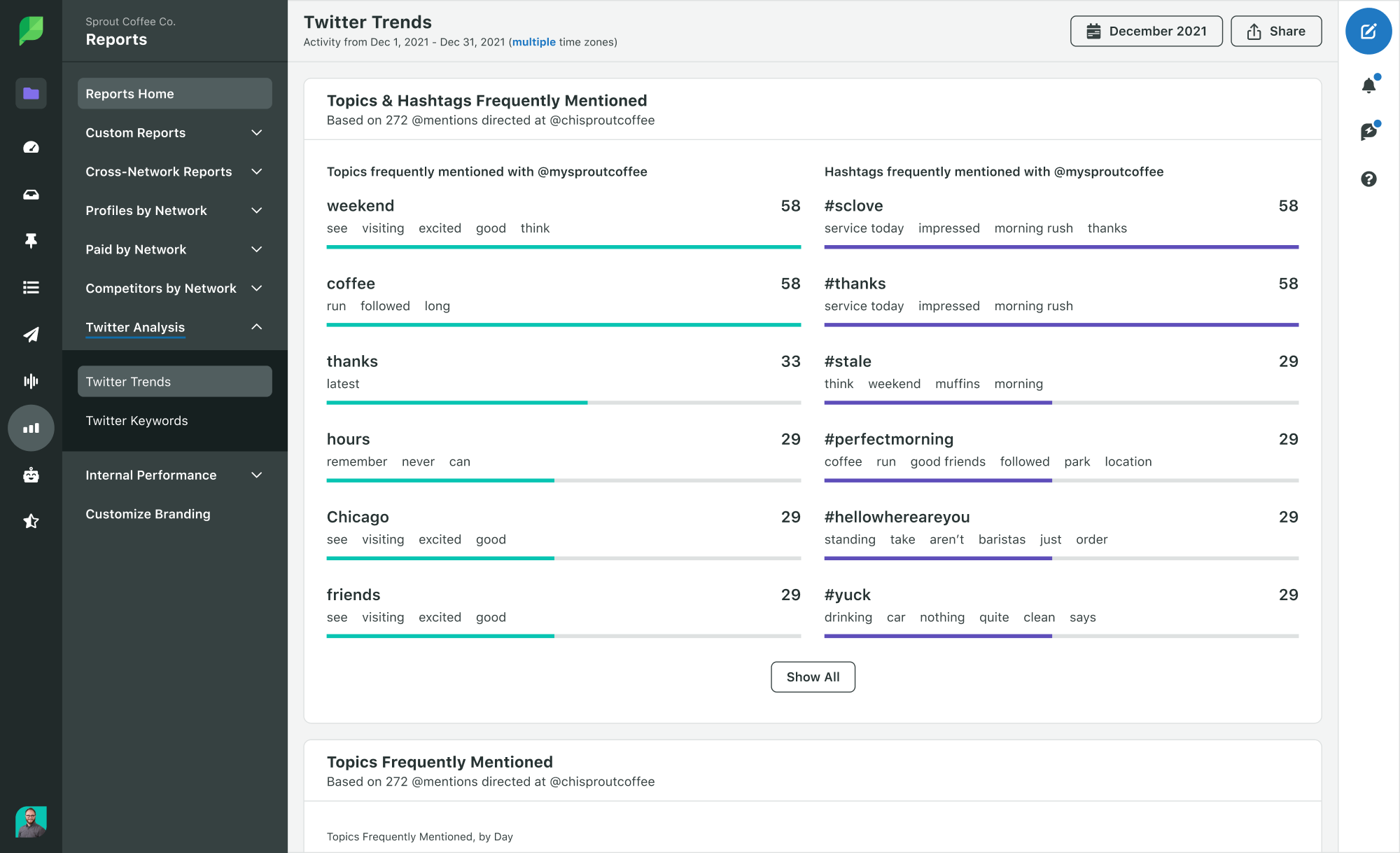Harnessing X (Twitter) sentiment analysis for strategic business insights
Table of Contents
Understanding and interpreting the emotions of your audience is a crucial component of any successful business intelligence strategy. In an era where social media platforms like X (formerly known as Twitter) have become global forums for public opinion, sentiment analysis has emerged as a vital tool for businesses.
Sentiment analysis is a technique used to determine the emotional tone behind words, and it’s particularly valuable for business intelligence. It empowers businesses to gain a deeper understanding of their customers and competitors while offering a birds-eye-view of prevailing market trends on social and beyond.
This article explores ways to use sentiment analysis on X and the methodology behind it. We’ll also take a look at how brands can use the wealth of data available on X to effectively harness social data to inform broader business conversations.
What is Twitter (X) sentiment analysis?
X sentiment analysis automatically classifies posts as positive, negative or neutral using AI-powered tools to reveal public opinion about your brand, products or industry trends in real-time.
This process uses natural language processing and machine learning to analyze emotional tone behind words, transforming raw social data into actionable business intelligence.
Smart brands leverage sentiment analysis to monitor brand health, predict market shifts and make data-driven decisions that drive competitive advantage.
How to use Twitter (X) sentiment analysis in business decisions
X sentiment analysis delivers strategic advantage through real-time market intelligence and competitive insights.
With X’s massive daily user base, sentiment data reveals critical business opportunities:
- Trend identification: Spot emerging market shifts before competitors
- Risk mitigation: Catch negative sentiment early to prevent reputation damage
- Competitive intelligence: Understand how audiences perceive rival brands and offerings
- Strategic positioning: Use consumer insights to inform product and marketing decisions

Also, sentiment analysis proactively reveals the public sentiment impact of various events you choose to track—like new product launches or campaigns. Looking at sentiment in the midst of campaigns allows you to make timely strategy adjustments rather than correcting course after an entire campaign-gone-wrong.
It’s no surprise that effectively leveraging sentiment analysis on X substantially increases the value of your business intelligence strategy.
1. Inform your competitive analysis
In the digital age, understanding your competitors is almost as important as understanding your customers. Analyzing the sentiment of your rivals on X uncovers how both your current and target consumers perceive your competitors and their offerings.
Performing an X sentiment analysis within your broader competitor analysis involves examining the types of content competing brands post on the platform, the responses they receive and the overall sentiment of the responses they get. This supports your ability to identify consumer trends, emerging opportunities and potential threats.
For instance, if sentiment analysis reveals your competitor’s audience is unhappy with a particular feature they offer, this is an opportunity for your business to differentiate itself by creating and delivering a superior alternative or by pointing audiences to an existing product or service that solves the same problem. By incorporating sentiment from social listening into your competitive analysis, you gain a data-driven understanding of your market rivals that you harness to benefit your business.
2. Improve customer experience
Customer experience strategy is the cornerstone of any successful business strategy, and X sentiment analysis increases customer satisfaction with real-time insights.
By monitoring the sentiments expressed in posts about your brand, you identify and address customer concerns fast.
This not only improves the customer experience but also increases your brand perception.
For example, if a customer posts a complaint about your brand’s product or service, you immediately address the issue and take steps to resolve it. Providing fast responses demonstrates that your brand prioritizes customer feedback and is committed to providing excellent service. In fact, consumers surveyed in The 2025 Sprout Social Index™ say brands need to start providing fast, personalized customer care on social in 2025.

Using X sentiment analysis as a part of your customer experience strategy is a way to significantly improve your relationship with your customers, which in turn improves your brand reputation.
3. Support product development and innovation
X sentiment analysis delivers unfiltered feedback about your products, which guides your product development efforts with data-driven marketing.
For example, if a tech company receives negative sentiment around a new software update, you surface that information to your product team so they make a specific change or improve the product in various ways.
Take Sprout Social’s release of dark mode as an example. Our social team used Listening and sentiment and noticed conversation around Sprout Social not having this coveted feature. Our social team brought the data back to our product team who then expedited our dark mode release that was already in the works.
Analyzing sentiment expressed in posts about your products makes it easier to determine existing unmet consumer needs and where there is room for your product to improve.
4. Strengthen brand reputation management
In our current digital age, negative sentiment spreads rapidly on social media platforms like X. Sentiment analysis allows you to monitor how audiences feel about your brand and address potential reputation risks immediately.
For instance, if sentiment analysis reveals a surge in negative sentiment about your brand, you quickly take corrective action.
This involves reaching out to dissatisfied customers, issuing a public statement or changing your messaging to address the issue.
By incorporating X sentiment analysis into your reputation management and social media crisis plan, you protect your brand image and build stronger relationships with your audience.
How Twitter (X) sentiment analysis typically works
Social media platforms such as X offer official APIs for sentiment analysis, but they require coding skills and technical knowledge. Historically, running sentiment analysis required developer resources and custom code. Today, marketers can integrate sentiment insights seamlessly through platforms like Sprout Social—no coding required.
When using a sentiment analysis tool powered by AI (like Sprout Social), marketers have the opportunity to fit sentiment analysis into their existing workflows, without jockeying for technical resources.
Twitter (X) sentiment analysis with Sprout Social
With Sprout Social’s acquisition of advanced technology in sentiment and textual analysis plus its integration with OpenAI, you do more with less.
Sprout Social’s platform offers a user-friendly way to analyze sentiment on X with sentiment analysis embedded within our Smart Inbox and Listening tools.
Here’s a breakdown of sentiment in Sprout Social and how you use it to analyze audience insights on X today.
Gather business intelligence at a glance with sentiment in Listening
Sprout Social processes an average volume of 600 million messages a day, and our sentiment model uses the latest tech to infer more about context and language across industries, so you get a more accurate picture of audience sentiment.
Use Social Listening to build topic queries and analyze conversations on X related to your topic.

This supports your understanding of consumer emotions around key topics and conversations.
After you build a query and select X as your Listening source, you view a Sentiment Summary that compiles data on all the messages and conversations happening around your topic.
You also review the Sentiment Trends chart to see how sentiment changes over the time period you selected.
Sudden or notable changes in your trend lines tell you when sentiment shifted–a sign that you need to dig deeper into the conversations happening around your brand.
To get even further context, you use Message Explorer to click into sentiment peaks and valleys to understand what messages drove those changes.

Categorize conversations by sentiment
Sentiment analysis works best when you examine positive, neutral and negative categories together. Looking at overall trends and reclassification patterns gives a clearer picture of how audience attitudes evolve over time.
When examining conversations happening around your brand in Listening, Sprout Social’s platform sorts the top related keywords and hashtags by sentiment for you. That way you view the most used keywords in all positive and negative conversations separately to get a better idea of what’s driving different sentiment around your brand.

Zooming out, you also filter all Listening data by sentiment–meaning you view only the positive, neutral or negative mentions and comments related to your broader topic across the entire Social Listening dashboard.
Analyze the sentiment of messages in Sprout Social’s Smart Inbox
Also, along with sentiment analysis in Listening, Sprout Social has AI-powered sentiment for messaging.
When you get a DM on X, the message gets classified as positive, neutral or negative.
This supports social customer care teams in prioritizing messages, improving efficiency and monitoring their brand health.
Reps handling X messages within Sprout Social’s Smart Inbox use this analysis to ensure they’re focusing on the right messages, first.
Pair sentiment analysis with other Twitter (X) reports
Use the sentiment data with other reports in Sprout Social to get the full picture of your brand’s perception on X.
You also review the cross-network reports on Sprout Social to see how X sentiment holds up in contrast to your other business social accounts.
How to implement effective Twitter (X) sentiment analysis strategies
Building an effective X sentiment analysis strategy requires three core steps that transform raw social data into strategic insights.
- Select the right platform: Choose AI-powered social media management platforms over manual coding approaches. Platforms like Sprout Social integrate sentiment analysis directly into your existing workflows, eliminating the need for developer resources.
- Define your framework: Set clear parameters for what you’ll track—your brand, competitors, industry keywords or campaign hashtags. Establish monitoring frequency based on your business needs and campaign cycles.
- Act on insights: Transform sentiment scores into strategic decisions. Focus on broader trends rather than individual posts to identify opportunities for engagement, product improvements or reputation management.
Challenges with Twitter (X) sentiment analysis
While X sentiment analysis provides a wealth of data and insights, it’s important to also acknowledge and navigate the challenges that accompany this process.
Here are a few challenges you’ll likely encounter in the X sentiment analysis process.
Data accuracy
Data accuracy presents the biggest challenge in sentiment classification due to the complexity of human communication on X.
Common accuracy obstacles include:
- Language nuances: Slang, abbreviations and grammatical errors
- Contextual interpretation: Sarcasm, irony and cultural references
- Visual elements: Emojis and symbols that alter meaning
- Complex sentence structures: Negations and comparative statements
A limited platform
Another challenge arises from the limitations of X’s data itself. User demographics vary highly in age, geographic location and country. When you’re a brand with a presence across multiple platforms and audience types, one platform’s users don’t provide a full picture of audience sentiment for your entire brand.
Users who post frequently, the prevalence of reposts and spam can also affect the quality and representation of data collected.
Ethical considerations and biases
When analyzing posts, it’s important to keep user privacy in mind.
Companies must not invade a person’s privacy while collecting sentiment data from social media.
Sentiment analysis algorithms struggle with cultural differences and language variations, particularly when analyzing X posts across different countries and languages. Selecting advanced AI-powered platforms with robust analytics capabilities ensures more accurate, culturally-aware sentiment detection.
Transform your business intelligence with Twitter (X) sentiment analysis
The future belongs to brands that listen, learn and act on real-time consumer sentiment.
X sentiment analysis transforms scattered social conversations into strategic intelligence that drives competitive advantage.
Smart organizations use sentiment insights to predict market shifts, prevent reputation crises and discover opportunities before competitors. The question isn’t whether you need sentiment analysis; it’s that you can’t afford to operate without it.
Ready to transform social data into strategic advantage? Discover how Sprout Social’s listening tools turn sentiment analysis into actionable business intelligence that drives measurable results.
Twitter (X) sentiment analysis FAQs
How accurate is Twitter (X) sentiment analysis for business decisions?
Advanced AI-powered platforms deliver high accuracy by understanding context and industry language, with the greatest value coming from identifying broad trends rather than individual posts.
What's the difference between free sentiment analysis tools and professional platforms?
Professional platforms like Sprout Social integrate sentiment analysis into your existing workflows and connect insights to customer care and strategy, while free tools lack the scale and support needed for business decisions.
How do I handle sentiment analysis across multiple social media platforms?
Analyzing sentiment on just one platform gives you an incomplete view of your brand’s health. You need a comprehensive social media management platform to track, analyze and compare sentiment across all your social media platforms, such as Facebook, Instagram and LinkedIn, from a single, unified dashboard.
Do sentiment analysis tools detect sarcasm and cultural context?
Advanced AI platforms continuously improve at detecting sarcasm and cultural nuances, though human oversight remains essential for complex conversations.
How often should I monitor Twitter (X) sentiment for my brand?
Monitor weekly for general brand health, but switch to real-time monitoring during campaigns, product launches or potential crises.



Share